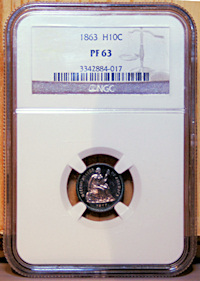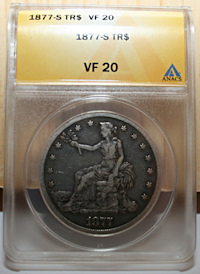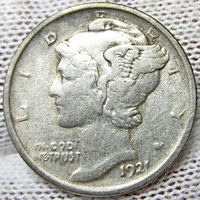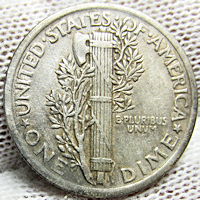PRESERVING THE HISTORY OF FOUND U.S. SILVER COINS

Epi-hunter (Angie)
Perhaps the most exciting aspect of metal detecting is that of the "unknown" - savoring the possibility that each and every target could be that one elusive, priceless, once-in-a-lifetime find. It is that feeling which keeps many of us going - the knowledge that even during a hard-luck detecting trip, that very last dig of the day has just as much potential for being that exceptional find as did the first dig.
Many coinshooters - particularly those who seek the older coins - have come to appreciate coins for their beauty, history, and - in some cases - their rarity. Recently, I have been reading and thinking about the difference between "coin collecting" and "numismatics".
I think many people fall under the first category, which refers to collecting sets of coins, often solely for their monetary value. The latter category appeals more to me, however. In contrast to a "collector", a "numismatist" is a person who studies coins and money. Numismatists approach the world of money more from a historic, social, or artistic sense. I think this fits well with why many of us find metal detecting so compelling and so exciting.
With that in mind, it is imperative that we as detectorists do as much as possible to ensure that the treasures we dig retain as much of their original history as possible. For purposes of this discussion, I will focus on coins found via metal detecting.
Recovering the Coin Safely
Several factors are crucial to avoid damaging a coin during and after its extrication from the ground.
First, dig every target as if you already know that it is the most rare of treasures, being as careful as possible not to nick or scratch it with the digger (and yes, most of us -- myself included-- have done this at one time or another). Make sure your holes are wide enough (within reason) to allow for digging around and under the coin. Use of a SunRay probe or a hand-held battery-operated pinpointer will aid in recovering the coin from the hole. I personally would not detect without use of an in-line probe, which gives me a very good idea of where in the hole the coin is located, so that I can avoid directly hitting it with the digger.
Evaluating and Cleaning the Coin
After recovering the coin, resist the urge to brush or clean the dirt from the coin by rubbing it with your fingers. This almost always results in surface scratches to the coin which may not be immediately visible to the naked eye, but they are very evident using magnification (yes... just rubbing your finger over a coin to clean the crusted dirt off will scratch it).
Once you get the coin home, rinse it with water carefully then softly pat dry with a cotton cloth, but do not rub, as this may also result in surface scratches.
Most importantly - do NOT clean or polish the coin! Cleaning the coin will result in a decrease in its historic and monetary value. Numismatists want coins to have their original toning and luster; polishing a coin to give it artificial luster will make the coin much less desirable, as the coin will no longer retain its original historic state. Furthermore, polishing or cleaning a coin in any way, even very carefully, will almost always leave scratches on the surface of the coin, causing irrevocable damage.
Why Do Coins Have Numismatic and/or Monetary Value?
Of note, coins do not have to be extremely old to be of numismatic value. Do not make the mistake of many detectorists by assuming that newer silver coins are too "recent" to be of value to collectors and numismatists. One example is the 1916-D mercury dime ("D" stands for minted in Denver).
From the Professional Coin Grading Service (PCGS) Web site:
"The 1916-D Mercury dime is one of the most heralded key dates of 20th century numismatics. If you collected coins in the 1950s or 1960s, you dreamed of finding a 1916-D dime... The 1916-D is rare in all grades. Walter Breen has written that mint production of dimes in Denver in 1916 was stopped so that personnel could devote full time to making quarters. The original mintage of 264,000 for the 1916-D is by far the lowest of the Mercury dime series. For comparison, the mintage of the 1916 was 22,180,080 and the mintage for the 1916-S was 10,450,000. The 1916-D is an extremely high demand coin in all grades and even very low grade examples sell for in excess of $1,000."
The 1916-D mercury dime is also one of the most commonly counterfeited coins, particularly among the more worn varieties where the evidence of counterfeiting is easier to conceal.
This is just one example of a rare coin with numismatic value. There are many more examples of coins with semi-key dates which are also of historic and monetary value. You, as a detectorist, should be aware that these coins exist within every denomination and design category, and although it might be impractical or impossible to memorize them all, even if you are not interested in coin collecting or numismatics, you should check the coins you have found using some of the resources I will list later in this discussion.
Several factors contribute to a coin's value. These include (as mentioned above) the rarity of the coin. The number of coins originally produced at the original mint ("mintage") will give indication of a coin's rarity - the lower the mintage, generally the more valuable and rare the coin. Another factor is "survivorship", which is an expert estimate of how many of a particular coin are still in existence (including total number, and just those in very high grades). A third factor is where the coin was minted. Mint marks are found on various places, usually on the reverse of the coin. Here is a list of US mints and the dates that coins were produced during this time:
- CC: Carson City (1870-1893)
- D: Denver (1906 to date)
- O: New Orleans (1838-1909)
- P: Philadelphia (Silver "Nickels" 1942-45; Dollar coins 1979 to date; other coins except cents 1980 to date. Although the Philadelphia mint has been operating continuously since 1793, most Philadelphia coins do not have a mintmark)
- S: San Francisco (1854 to date. Now mints collector coins only. The last circulating coin to bear an 'S' mintmark was the 1980-S SBA Dollar)
- W: West Point (1983 to date; collector coins only)
A fourth factor related to a coin's value is its condition, which I will discuss in a bit more detail below.
An Introduction to Coin Grading
Grading coins is something which fascinates me, and I personally enjoy the challenge of grading coins. Grading refers to assigning the coin to a category based on its condition. Grading of circulated coins is based on the 70-point Sheldon scale, which ranges from a grade of Poor (P-1) to Perfect Mint State (MS-70). You can find a description of these categories via the PCSG site HERE. The most common key points of this scale are reviewed below:
AG-3 (About Good-3): Coin is flat, with few details remaining and with lettering in the rims completely worn
G-4 (Good-4): Coin is flat, heavily worn, and the inscriptions may merge into the rims in places, but the rims are mostly intact
VG-8 (Very Good-8): Very worn, but all major elements are clear, although faint; main features are clear and bold
F-12 (Fine-12): Still quite worn, but wear is even, and overall design elements stand out boldly
VF-20 (Very Fine-20): Moderately worn, with some finer details remaining; if present, all letters of LIBERTY should be readable; rims should be clear and full
EF-40 (Extra Fine-40): Lightly worn; some signs of original luster may be present
AU-50 (About Uncirculated-50): Slight traces of wear on high points; may have contact marks; little eye appeal
AU-58 (Very Choice About Uncirculated): Slight hints of wear marks, no major contact marks, almost full luster, positive eye appeal
MS-60 (Mint State Basal): Uncirculated, but poor eye appeal; contact marks may be present
MS-63 (Mint State Acceptable): Uncirculated, but with contact marks/nicks and slightly impaired luster
MS-65 (Mint State Choice): Uncirculated with strong luster, very few contact marks, excellent eye appeal
MS-70 (Mint State Perfect): The perfect coin. No microscopic flaws visible to 8x; sharp strike; full and original luster present
One of the most misunderstood aspects of coin grading is how the grading scale works. There are essentially three categories of grading:
1) circulated coins (through EF grades)
2) "about uncirculated" coins (the AU grades)
3) uncirculated coins (the MS scale). So, the scale is not continuous.
For example, a coin graded AU-58 is a circulated coin but with excellent eye appeal, but the next "higher" grade (MS-60) is an uncirculated coin but with much less eye appeal. You must first be aware of these categories, and determine into which your particular coin falls, before grading.
Grading coins requires a good light source (100-watt bulb in a lamp close to your work source) and a decent magnifier (5x-8x; not lower or higher).
There are many sites which assist with grading coins. One site which focuses on visual grading of coins is located HERE.
Examples of Professionally Graded Coins
Many people will send rare and/or valuable coins to one of the three main coin grading services to have them professionally graded and slabbed. The three main coin grading services include the Professional Coin Grading Service (PCGS), the Numismatic Guaranty Corporation (NGC), and American Numismatic Association Certification Service (ANACS). The advantage is that the coin will be authenticated (to ensure it is not a counterfeit) and professionally graded.
Following are two examples of coins that have been professionally graded.

The first is a coin that I recently acquired to add to my collection. It is an 1863 seated liberty half dime. You will note the designation "PF 63", which is the grade assigned to the coin by the grading company.
"PF"(sometimes also designated as "PR") represents a special category of uncirculated coins called a "proof". These coins were struck using a special die (usually polished and double-struck) and not released in circulation. Only a small number of these coins were struck, so they are generally quite collectible. Here you can see the grading and slabbing from the professional service.
In this example, there were only 460 proof coins of this year and denomination minted. This particular coin shows rainbow toning, although it doesn't show well in the photo.
The natural toning of a coin is important and desirable to numismatics.
The second example is a 1877-S circulated trade dollar which was graded at VF-20 (Very Fine-20).

Professional graders will determine instantly if a coin has been cleaned, and they will typically refuse to assign it a grade. If the professional service determines that a coin has been cleaned or polished, they will designate the coin to have "VF details (or whatever grade they would have otherwise determined the particular coin to be) - Improperly Cleaned". This devalues the coin substantially and is a reason to avoid cleaning the coin at all.
A Coin Grading Example for the Amateur Collector/Numismatist
I thought it would be fun to go through an example of grading a coin - using one dug by angellionel. This beautiful 1921 mercury dime is a semi-key date and is of relatively low mintage. It is highly sought after, particularly in great condition like this one. Keep in mind that I am an amateur and giving my grading opinion only, just for purposes of example.

This coin was a challenge to grade, particularly because the coin's obverse (front) appears more worn than the reverse (back). Typically, in cases like this, an average grade will be assigned, with a bit more weight assigned to the condition of the obverse. However, after researching this particular coin, several sources revealed that this specific mercury dime may have been weakly struck on the obverse - therefore, the greater wear on the obverse is not as heavily considered, and the reverse of the coin dominates when grading.

In the case of mercury dimes, the bands on the reverse fasces determine much of the grade, because they are among the first to show wear. In this case the vertical bands are distinct and not worn, and the diagonal bands are three-dimensional. There is original mint luster still present. Angel and I determined this coin to grade between XF-40 and XF-45. This dug coin is valued monetarily at approximately $600 according to the 2011 RedBook (coin retail) pricing.
Coin Resources
I use PCGS coin grading and professional services, and this allows me to have access to instant information on the mintage, survivorship, historic background, grading details, and associated monetary value of almost any coin. However, there are many free resources that can be used to look up some or all of this information. Some examples are provided below:
Mercury Dime
NGC Coin Price Guide
USA Coin Book
US Coin Photo Grade Comparison Charts
Copper Grading Guide
LargeCents.net
CoinTrackers.com
You will note that I focused exclusively on US silver coins in this writing. However, similar standards exist for copper coins (both early and more modern). In fact, there are so many varieties of copper coins that many numismatists focus only on a particular date range of copper coins. Angel's article in last month's newsletter discussed the numerous varieties and nuances associated with collecting copper coins.
As detectorists, we have real opportunities to find and save pieces of history that have long been buried. We just have to make sure we treat the coins we find with the respect they deserve, and continue to preserve their history and value.
"The moment that the collector begins to value coins because of their rarity, he descends in the scale of Science; and when he seeks to possess rare coins merely because of their being rare, he becomes a speculator, envious and uncomfortable in the presence of others, and ceases to be a genuine Numismatist.
Read as you collect. Never let a coin lie in your cabinet that you cannot give the history of, or connect with some historical event if it be possible. Be careful that your collecting does not become a mere matter of curiosity. Let it rather be a constant aid to your study."
(From The American Journal of Numismatics April, 1872)
|